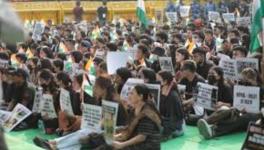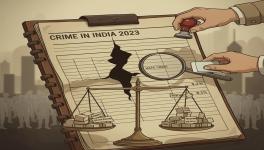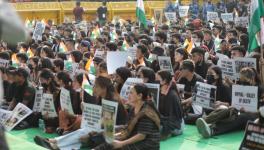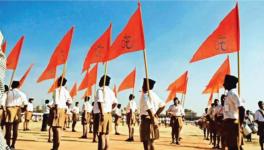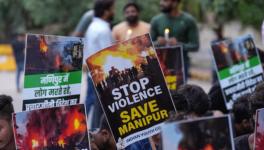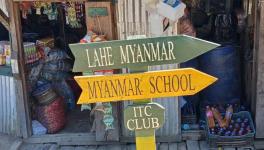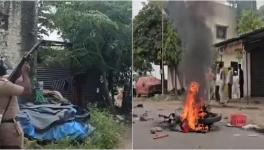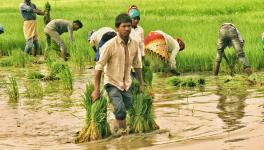Is Manipur the Most Recent Hindutva Experiment?

Image for representational purpose. Credit: PTI
A video that recently surfaced on social media has brought attention back to Manipur. Two naked Kuki women being paraded by a Meitei mob and led to a field in Nongpok Sekmai in Thoubal district has hit the conscience of the nation. Within hours of the video going viral, the Manipur Police responded with a statement that claims that the incident happened on May 4, 2023 and that an FIR had been filed against unknown miscreants, carefully hiding the fact that the FIR was filed on May 18.
This was followed by several mainstream media editors and journalists, who were silent until then, to come up with adjectives to explain their shock, and analyse the causes of this particular incident with a clear timeline, which had evaded celebrated journalism for 77 days. This warrants special mention since only a handful of journalists were committed to reporting the violence in Manipur so far.
The Minister for Women and Child Development, Smriti Irani, took to Twitter to give a carefully worded, but vague statement that condemns the horrific event and proclaims the assurance that the Chief Minister of Manipur, N. Biren Singh, had given her regarding punishing the criminals. The Prime Minister, outside Parliament before the beginning of the Monsoon session, said that 140 crore Indians were in shame at the horrific incident, again careful to not speak much, just enough for the nation to see that he had acknowledged the issue.
How did the violence that started in Manipur on May 3 evade mainstream media and public discussions? How can a state in a democratic republic be up in arms, witnessing horrific violence for more than two months? Why have the Union government and the state government been largely silent regarding the violence? The answers to the given questions are not as complex as one might think.
The Successful ‘Othering’
The majority community Meiteis largely follows the Hindu caste system and are not considered tribals as per the Backward Classes Commission chaired by Kalelkar. In fact, Meiteis themselves chose to be out of the Scheduled Tribe list, for they looked down upon the tribes, and called them ‘Hao thu’, a derogatory term used in the recent violence as well. Across the bureaucracy and educational institutions, the Meiteis are in higher positions. The State, media, and all public institutions are accessed and controlled by the privileged majority community. Almost 100% of the general quota across institutions are filled by the Meiteis, pushing the tribals to their reserved seats. As inhabitants of the more developed valley, the Meiteis have been largely the beneficiaries of whatever development the state had witnessed.
And yet, for a few years now, the narrative that the Meiteis are turning into a minority, that the population of the Kuki tribe is increasing, and that the tribals are taking away their jobs and seats in educational institutions by way of reservation, has been in play. Much like the Right-wing narration of “Hindu khatre mein hai”, a baseless and vicious narrative on the majority in Manipur “losing out” to the minority was built and carefully crafted to generate a sense of ‘othering’ and hatred for each other. What can be called a fear psychosis took its full form in the recent incidents of violence that started early in May and continues to this day.
The Meitei community had submitted several requests and petitions to include their community in the ST list. On March 27, acting Chief Justice M V Muralidharan, passed an order directing the government in Manipur to recommend the inclusion of the Meitei community in the ST list. This order is considered the immediate trigger for the current violence in the state. Why would the privileged Meitei community, which largely follows the caste system, want to be listed as ST? The objective is not only reservation in education and employment, but a larger economic one – land.
Protected under Schedules 5 and 6 of the Indian Constitution, the tribals in Manipur have access to the hills and an Inner Line Permit devised by the British separated the valley and the hills. The non-tribal Meitei group could not buy land from tribals of the hills, thereby collectively occupying valleys in large numbers. The increase in population as years passed by led to the demand for more land, which was not available for them to buy. Inclusion in the ST list was the majority community’s shot at trying to access more land in the hills, which they thought was unjustly kept away from them.
The ‘othering’ of the tribals did not start recently. The entire development saga of the state clearly shows that the valley has developed out of proportion, leaving out the larger landmass and the minority population. The socioeconomic and political achievements of the Meiteis, as mentioned earlier, are examples of the same. The ‘othering’ has been strong and there have been multiple armed militant groups for decades who have been fighting for the separation of the hills.
The tribal Kuki community has been asking for an autonomous territory owing to the discrimination they face. An interesting fact is that while the tribal bodies that protested against the Meitei getting ST status included the Nagas along with the Kuki tribes, the former are left out of the violence in the state.
Riot or Pogrom?
"No riot can last for more than 24 hours without the consent of the state", said Vibhuti Narain Rai, the Ex-Director General of the Uttar Pradesh Police, in an interview with Teesta Setalvad in 1995. The fact that the riot in Manipur has been going on for over two months now, and with the alleged support from the State is, therefore, quite strange.
The Armed Forces Special Powers Act (AFSPA) limits was lifted from Wangoi, Leimakhong, Nambol, and Moirang, the foothills connecting the valley and the hills of Manipur in March this year. The armed forces have been rendered spectators, not allowed to enter the regions where armed conflicts have been taking place. Any attempt of intervention by the forces has been met with hostility. The silence of the Union government has made it further difficult for them to act.
While the Kukis have been accused of a history of militancy and access to weapons, it was a group of Meiteis who attacked armouries and took hold of sophisticated weapons. Even though the police is allowed to shoot at anyone who tries to snatch weapons, the sheer ease with which these groups could take away the weapons sheds light on the “support” that the police may have given them.
Right from the beginning of the ethnic conflict, commentators, including retired Army officials, have written about the “nexus” between politicians and valley-based terrorists. Major Amit Bansal, a retired official, had accused the ruling party of removing all Kuki police personnel and administrative officers including the DGP from active duties, ensuring that power was controlled by the Meitei.
Accounts of several victims have come out stating that the police were mute spectators in the violence unleashed upon the Kukis by members of the Meitei community. The survivor of the mob violence, of which the video has surfaced, has accused of the police of taking them away from their house and handing them over to the mob after which they were stripped naked, paraded, and raped.
The fact that an FIR was filed on May 18, against “unidentified” persons, and one of them was arrested within 24 hours of the video surfacing, actually points toward the priorities of the police force. Chief Minister N. Biren Singh, openly admitted in national media that there are a hundred such cases in Manipur. Yet, why has he been silent and the police inactive, until a video went public? This is a question that would open the Pandora’s box. Sanity leads one to believe that the State has aided in leading Manipur to where it is today, all the more reason to doubt that it is a pogrom and not a mere riot between two communities.
Carefully Engineered Experiment
The genocide in Manipur did not start overnight. It can be seen as the result of a carefully engineered project that has been on for decades. The polarisation, the insecurity, and the enmity have been in place for years. Tagging the protesting tribals as infiltrators and illegal refugees was devised by sections of the majority community to justify their acts of violence. This draws scary parallels to what happened in Gujarat in 2002 where sections of the majority community attacked the minority community, calling them ‘infiltrators’, and justifying their acts as an attempt to “show them their place”.
The Right-wing politics of the country has been using this tactic since its inception -- create a sense of insecurity among the majority community that they are falling in numbers, losing out their resources to ‘encroachers’, and are in direct attack from the ‘violent’ minority. A fear of ‘losing out’ and a fear of the ‘non-deserving’ taking away their fortunes have been etched into the minds of sections of the majority, leading to acts of violence across the country by Hindutva forces. All sense of humanity and fraternity is lost when this kind of insecurity and hatred take over. And all this is built upon what the founding fathers of the Hindu Mahasabha and the Rashtriya Swayamsevak Sangh have envisioned.
It was Vinayak Damodar Savarkar, the Right-Wing icon, who popularised the term ‘Hindutva’. In 1937, at the 19th Session of the Akhil Bharatiya Hindu Mahasabha held at Karnavati, Savarkar said, “It is safer to diagnose and treat deep-seated disease than to ignore it. Let us bravely face unpleasant facts as they are. India cannot be assumed today to be a unitarian and homogeneous nation, but on the contrary there are two nations in the main: the Hindus and the Moslems in India”. This proclamation that Hindus and others cannot live in unison in India was way before the ‘two-nation’ demand became stronger from MA Jinnah and his companions. Hindutva and Hindu Rashtra have always been about ‘ousting the others’ – Muslims and Christians – and the RSS and their political wing, the ruling Bharatiya Janata Party, have been toiling to realise this dream.
Savarkar, in his “Six Glorious Epochs of Indian History” says, “Every Hindu seems to have been made to suck, along with his mother’s milk, this Nectar-like advice that religious tolerance is a virtue… In respect of these intolerant foreign religions [Islam and Christianity] the very extremely enraged intolerance, which seeks to retaliate their atrocities with super-atrocious reprisals, itself becomes a virtue” (para 429-430). It is in this book that he justifies the use of raping Muslim women. In fact, he goes on to explain that not doing so when the occasion permits is not virtuous or chivalrous but cowardly.
It is this mode the RSS has been adopting for showing Muslims and the minorities “their place” since BJP came into power in various states. This is what was tried in Kathua in 2018, where an eight-year-old Bakerwal girl was abducted and raped allegedly in a temple. The ultimate objective was not rape, but to send a message to the Muslim nomadic tribe that they were not welcome in the neighbourhood. The fact that processions in support of the accused were held by Right wing groups, also attended by two BJP ministers, reinforce the claim. A similar case is of the support that the convicts in the Bilkis Bano gang-rape case received when they were freed after the Gujarat government granted remission. They were greeted with garlands at the Vishwa Hindu Parishad office, sending out a spine-chilling message that they were simply following Savarkar in their ultimate mission.
Rapes in this context cannot be dissected with the man-woman power dichotomy alone. Hindutva is patriarchal, and patriarchy is not propagated by men alone. The sense of honour and pride in one’s own community is injected and placed at a higher level than gender dynamics here. Often, mobs that rape and kill their “enemies” consist of women as well, who call for these heinous acts. The hatred and bigotry are engraved so deep in their minds that basic empathy, compassion and sisterhood are lost in their war for their community. In this case, the victims aren’t women, but Kuki women who “deserve” whatever falls upon them.
An important group that warrants special attention here is Meirapaibis, the women’s group in Manipur, who are known for their protest by stripping themselves naked against the armed forces. They have been allegedly sheltering terrorists and have been allegedly escorting armed terrorists to Kuki villages, stopping armed forces from intervening. An instance of them allegedly burning alive a Meitei woman and her child in an ambulance, because she was married to a Kuki man, was brought to public attention.
Ironically, social media has seen the latest horrific video being defended as a “staged act by Meirapaibis”, when in reality, they have been reportedly siding with the Meitei in their attack against Kuki women, shattering the image they had for feminists and others, in their fight against the injustice of the armed forces in the state.
The very reason that Manipur can draw multiple parallels with the Gujarat 2002 and Delhi 2020 communal violence is because they’re all engineered along similar lines, for a larger goal – building a Hindu Rashtra. That the insecure group in Manipur belongs to the majority community, which largely follows the Hindu caste system, and seems mesmerised by Savarkar and his modus operandi, cannot be looked over.
Hence, Manipur can only be considered as a new location where the Hindutva forces are executing their tactic. The criminal inaction of the Union government and the popular media, as seen in other acts of violence against the minority of the country, reinforces this argument.
The attempt of the European Parliament to discuss the Manipur issue and adoption of an Urgency Resolution was met by the Ministry of External Affairs with a strongly worded statement that “interference in India’s internal affairs is unacceptable, and reflects colonial mindset”. With sheer arrogance, the statement also “advised” the European Parliament to “utilize its time more productively on its internal issues”. Obviously, the government has been observing the happenings in Manipur, and chose not to intervene.
The state and Central governments have not only been silent at the violence but active in attacking those who spoke up against it. In an attempt to silence all efforts of intervention, FIRs have been filed against several people across the country who spoke regarding the happenings in Manipur. A three-membered fact-finding team consisting of Annie Raja and Nisha Siddhu of the National Federation of Indian Women and advocate Deeksha Dwivedi were charged with sedition (124A) and other sections of the IPC for acting against the unity and integrity of the state for describing the crisis in Manipur as a “state-sponsored violence”.
The silence of the Union government regarding the violence, the attack against an Opposition political leader who tried to understand the situation, the reported ban on journalists from entering the hills for reporting the happenings, and the alleged complicity of the state machinery with groups belonging to the majority community raises serious questions about the State’s role.
Several weeks after the Home Minister briefed the Prime Minister about the situation in Manipur, no holistic report has come out, there is no visible action by the Union government, and the world is in the dark regarding the real state of affairs in Manipur. Unfortunately, what we are witnessing now is the ‘idea of India’ dissipating right in front of our eyes, and our brothers and sisters being killed, raped, and rendered homeless. All this for building a Hindu Rashtra?
The writer is an independent journalist. The views are personal.
Get the latest reports & analysis with people's perspective on Protests, movements & deep analytical videos, discussions of the current affairs in your Telegram app. Subscribe to NewsClick's Telegram channel & get Real-Time updates on stories, as they get published on our website.










